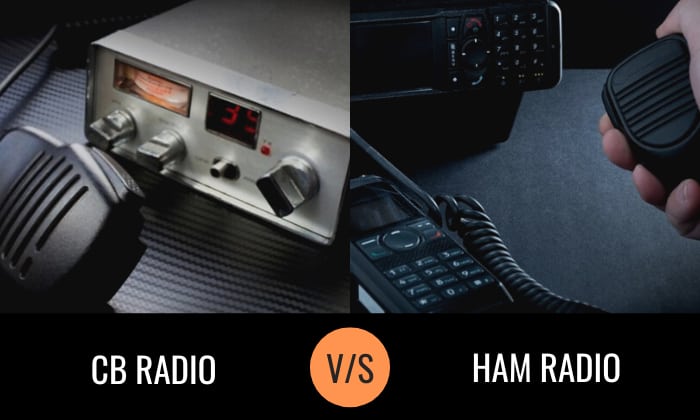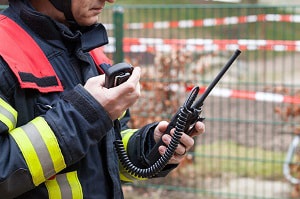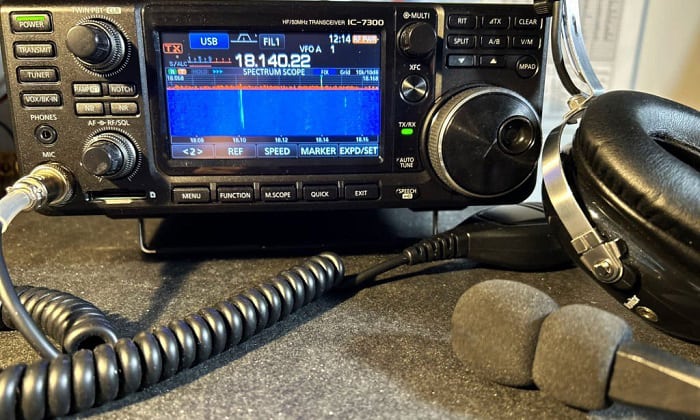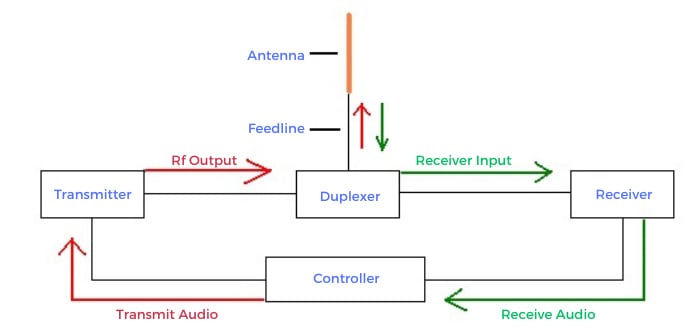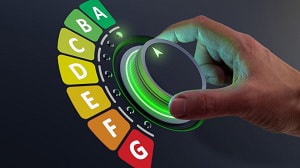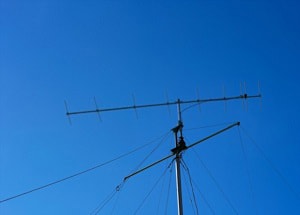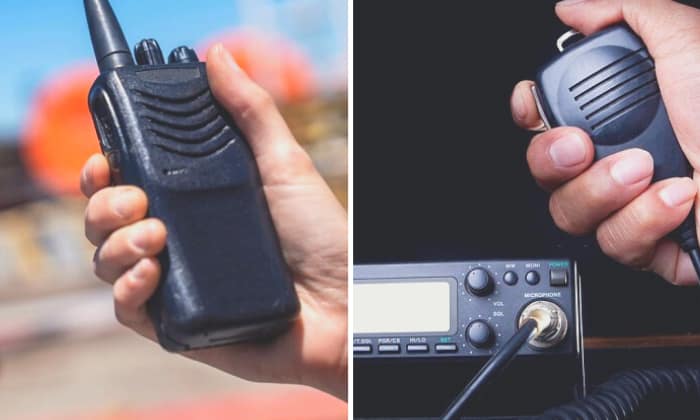If you are asking yourself, “is a CB radio the same as a ham radio?”, you are in the right article to know the differences between the two. You’ll discover in this post how they separate from each other in many categories, so no need to be confused.
See the table below for a quick comparison when talking about CB radio vs ham radio. Know that these are just general information and may not apply to all cases of the two but if you want to know more, continue reading below.
| CB radio | Ham radio | |
| Application | Personal or small-scale communication, often in vehicles or homes | Amateur and professional communication, experimentation |
| License | None | Required |
| Range | 2 – 50 miles | 1 – 2500 miles |
| Radio Experimentation | Limited | High |
| Power | 4 watts | 50 – 1500 watts |
| Frequencies | 40 channels between 26.965 and 27.405 MHz | Multiple frequency bands, including VHF, UHF, HF, and more |
| Modes of operation | AM, SSB | Various, including AM, SSB, FM, CW, and more |
| Antennas | Simple | Can be complex and require tuning |
Contents
What is a CB radio?
CB radio stands for “Citizens Band radio,” which is a type of two-way radio communication system that operates on 27 MHz bands. The CB radio meaning is that it is designed for short-range communication, typically up to a few miles, and is available for public use.
It’s popular among truckers and travelers because it doesn’t require CB radio licensing, so it’s perfect for communication on the road. Depending on the Federal Communications Commission (FCC), there may be restrictions on the antenna type, the power output, and how many channels of the CB radio wavelength you can use.
How does a CB radio work?
If you are a newbie and trying to work a CB radio, there are a lot of tutorials available online like those guides that give importance to CB radio for dummies.
But for some details, this type of radio works on 40 channels between 26.965 MHz and 27.405 MHz.
Here’re the types of CB radios:
- Base station
- All-in-handsets (with an ergonomic design)
- A mobile style
- Handheld (walkie-talkie)
You can get mobile or handheld CB radios that range for a few miles. A mobile CB radio is usually mounted in a car, and it has a bigger transmitter and antenna, so it can talk longer distances.
CB radios that are handheld are more portable and can be carried around, but they typically have a smaller transmitter and antenna, so their range is limited.
What is Ham Radio?
A ham (amateur) radio is a type of two-way radio that is popular among radio experts, who use it to communicate with other ham radio operators, participate in contests, and experiment with different radio equipment and techniques.
Ham radios aren’t like other radios because you have to get a ham radio license from the government before you can operate one. By getting this license, ham radio operators know how to operate their equipment without interfering with other radio communications and are knowledgeable about radio operation and safety.
How does it work?
You can use ham radios on a variety of frequencies, depending on the radio and the operator’s license. Aside from voice communication, ham radios can also be used for digital communication, such as sending and receiving text messages or transmitting images.
However, the operator must obtain the legal requirements needed to work with one.
Comparison of the Differences
The following are the major differences between the two radio types. Specifically, these compare their ranges, frequencies, channels, powers, and antennas.
1. Range
| Radio Type | Handheld | Mobile | Station-Based |
| CB Radio | Up to 1 mile (1.6 km) | Up to 10 miles (16 km) | Up to 30 miles (48 km) |
| Ham Radio | Up to 5 miles (8 km) | Up to 50 miles (80 km) | Up to hundreds or thousands of miles (2500 miles) |
Various factors can affect these ranges, such as terrain, antenna height, power output, etc. The range of ham radio can also change a lot depending on the frequency band used, as well as other factors. For station-based ham radios, the range can be great if they’re equipped right.
2. Frequency
Typically, CB radios work in the 11-meter band at a low frequency between 26.965 and 27.405 MHz, which is good for short-distance communication.
On the other hand, ham radio uses a broader spectrum, including Very High Frequency (VHF), Ultra-High Frequency (UHF), High Frequency (HF), and Very Low Frequency (VLF), depending on the license they have.
| Frequency range | Approximate Reach | License | |
| CB Radio | 26.965-27.405 MHz | 1-10 miles | None |
|
Ham Radio |
VHF (144-148 MHz) | Up to 50 miles |
Required |
| UHF (420-450 MHz) | Up to 20 miles | ||
| HF (3-30 MHz) | Hundreds or thousands of miles | ||
| VLF (3-30 KHz) | Special-ranged communication (e.g., submarine communication) | Requires special permission |
3. Channels
CB radio typically operates on 40 channels within the 27 MHz band, while ham radio operates on a wide range of frequencies across the VHF, UHF, and HF bands, including several dedicated bands reserved exclusively for amateur use. Ham radio operators can also use a wider variety of modes and modulation types, including FM, SSB, CW, and digital modes, while CB radio is primarily limited to AM.
4. Power
Generally, CB radios can only output 4 watts of power for AM and 12 watts of power for SSB, but some radios can be modified to go above those limits. In contrast, Ham radios have power outputs that can range from a few watts to several kilowatts, depending on the license type and equipment.
A ham radio’s higher power output allows it to transmit longer distances and penetrate obstacles like hills and buildings better. CB radio, alternatively, has a lower power output and may not interfere with other radio services, so it’s better for short-range communications within a local area.
5. Antenna
Antennas for CB radios usually have a small gain and are designed to be mounted on vehicles. They’re usually optimal at 8.5 feet long and have a gain of 3-4 dBi.
The antennas on ham radios, on the other hand, can be longer and higher-gain, and they’re designed for stationary base stations. It depends on the frequency and range, these antennas can be a few feet to several hundred feet long, and they can get 6 dBi or more gains.
Ham Radio vs CB: Pros and Cons
Here is a more comprehensive but short comparison of their advantages and disadvantages.
| Pros | CB Radio | Ham Radio |
| Newbie-friendly | ✔️ | ❌ |
| Affordable | ✔ | ❌ |
| License-free | ✔ | ❌ |
| Excellent short-range communication | ✔ | ❌ |
| Covers truckers and off-road enthusiasts | ✔ | ❌ |
| Emergency communication usage | ✔ | ✔ |
| Mobile communication | ✔ | ✔ |
| Experimentation-friendly | ❌ | ✔ |
| Wide-range access of frequencies | ❌ | ✔ |
| Performs local and international communication | ❌ | ✔ |
| Strict users regulation | ❌ | ✔ |
Cost
There’s a big difference between CB and ham radio equipment in terms of price. The latter usually comes with more features and capabilities than CB radio equipment, which makes it more expensive. It’s more powerful, longer-range, and has more frequencies than CB radio.
A CB radio, however, is generally more affordable and accessible to the general public. It’s used by truckers, travelers, and radio users who need a simple, affordable way to communicate.
So, the main difference between CB and ham radio is the cost of equipment and the level of features and capabilities (as explained above). In general, CB radio equipment is more affordable, accessible, and simple than ham radio equipment, which is typically more expensive, requires a license, and offers more advanced features.
Frequently Asked Questions
Do truckers use ham or CB radios?
Truckers primarily use CB radios for communication while on the road, especially for survival in emergencies, because they are typically more affordable and accessible than ham radios.
Additionally, the range of how far CB radio can communicate is generally sufficient for most truckers’ needs, as they typically only need to reach other colleagues in close proximity.
Can ham radio hear CB?
Yes, it can but with limitations. For example, it cannot enable CB frequencies on a ham radio to be transmitted without modification or the use of additional equipment so doing this might be expensive.
To have a ham radio with CB channel availability, you need to add more programming and adjustments. This means that it’s hardly possible for you to convert ham radio to CB because it may also not have all the features and capabilities of a dedicated CB radio.
Moreover, some units have the ability to program in CB frequencies, allowing the operator to use a ham radio as a CB receiver. However, it is not legal to transmit on CB frequencies using a ham radio unless the needed modifications and legal requirements are obtained.
Conclusion
When comparing these two, the choice of which is better is highly subjective. Some professionals may argue that ham is superior but the citizens may rebuttal otherwise.
So, we hope that you’ve learned something useful from this CB radio vs ham radio guide. If you want to read more related topics, we have numerous posts you can choose from. You may read how shortwave radio vs ham radio contrast each other, for example, and a lot more topics on this website.

Hello! I am Hart, the content writer and editor here at G0HWC. I used to be in the same local radio club with Howe, and he convinced me to join him in spreading my love for the radio with others. With a background in radio studies, I spend every day crafting accurate, easy to read content on various topics related to owning and using radios. I hope that my content can help you confidently venture in your radio journey!

